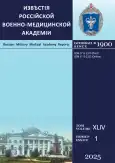Diagnosis of Acute Aortic Syndromes Using Computed Tomography
- 作者: Ryazanov V.V.1, Sadykova G.K.1, Gozheva A.R.1, Kutsenko V.P.1, Menshikova S.V.1
-
隶属关系:
- Saint Petersburg State Pediatric Medical University
- 期: 卷 44, 编号 1 (2025)
- 页面: 113-121
- 栏目: Discussion
- URL: https://bakhtiniada.ru/RMMArep/article/view/310895
- DOI: https://doi.org/10.17816/rmmar654012
- ID: 310895
如何引用文章
详细
Acute aortic syndrome refers to a group of life-threatening conditions characterized by acute injury to the aortic wall, primarily involving disruption of the intima and media. Acute aortic syndrome encompasses a spectrum of interrelated and overlapping clinical and morphological entities, including classic aortic dissection, intramural hematoma, penetrating aortic ulcer, and limited intimal tear. Differentiation of these variants based on clinical presentation and physical examination findings is not feasible. Imaging plays a pivotal role, and definitive diagnosis and classification of acute aortic syndrome variants are possible only through imaging studies. Multidetector computed tomography, transesophageal echocardiography, and magnetic resonance imaging are the primary imaging modalities used for the diagnosis of acute aortic syndrome, with contrast-enhanced multidetector computed tomography considered the gold standard. When classical imaging signs of a specific type of acute aortic syndrome are present, diagnosis is generally straightforward. However, a broad spectrum of imaging findings exists. In some cases, a single computed tomography scan may not allow for reliable differentiation among acute aortic syndrome variants. This limitation arises from the fact that these pathological entities may occur independently, progress from one to another, or coexist. The pathophysiology and clinical course of intramural hematoma and penetrating atherosclerotic ulcer of the aorta remain subjects of ongoing debate. In particular, the classification of intramural hematoma as a distinct acute aortic syndrome variant continues to be controversial. This article provides a concise overview of the current understanding of the pathophysiology, natural history, prognosis, and multidetector computed tomography-based diagnosis of the less common acute aortic syndrome variants, specifically intramural hematoma and penetrating atherosclerotic ulcer.
作者简介
Vladimir Ryazanov
Saint Petersburg State Pediatric Medical University
Email: 79219501454@yandex.ru
ORCID iD: 0000-0002-0037-2854
SPIN 代码: 2794-6820
MD, Dr. Sci. (Medicine), Associate Professor
俄罗斯联邦, Saint PetersburgGulnaz Sadykova
Saint Petersburg State Pediatric Medical University
Email: kokonya1980@mail.ru
ORCID iD: 0000-0002-6791-518X
SPIN 代码: 3115-7430
MD, Dr. Sci. (Medicine)
俄罗斯联邦, Saint PetersburgAlla Gozheva
Saint Petersburg State Pediatric Medical University
编辑信件的主要联系方式.
Email: gozhevaaa@mail.ru
ORCID iD: 0009-0004-9295-9821
SPIN 代码: 5597-7266
俄罗斯联邦, Saint Petersburg
Valery Kutsenko
Saint Petersburg State Pediatric Medical University
Email: val9126@mail.ru
ORCID iD: 0000-0001-9755-1906
SPIN 代码: 5760-0218
MD, Dr. Sci. (Medicine)
俄罗斯联邦, Saint PetersburgSvetlana Menshikova
Saint Petersburg State Pediatric Medical University
Email: s-menshikova69@mail.ru
ORCID iD: 0000-0003-2448-6116
SPIN 代码: 6879-2474
俄罗斯联邦, Saint Petersburg
参考
- Clinical Guidelines. Guidelines for the Diagnosis and Treatment of Aortic Diseases (2017). Russian Journal of Cardiology and Cardiovascular Surgery. 2018;11(1):7–67. EDN: YPAKRP
- Pereira AH. Intramural hematoma and penetrating atherosclerotic ulcers of the aorta: uncertainties and controversies. J Vasc Bras. 2019;18:e20180119. doi: 10.1590.1677-5449.180119
- Rubin GD, Leipsic J, Joseph Schoepf U, et al. CT angiography after 20 years: a transformation in cardiovascular disease characterization continues to advance. Radiology. 2014;271(3):633–652. doi: 10.1148.radiol.14132232
- Ferrera C, Vilacosta I, Cabeza B, et al. Diagnosing Aortic Intramural Hematoma: Current Perspectives. Vasc Health Risk Manag. 2020;16:203–213. EDN: PXTUEE doi: 10.2147.VHRM.S193967
- Gutschow SE, Walker CM, Martínez-Jiménez S, et al. Emerging Concepts in Intramural Hematoma Imaging. Radiographics. 2016;36(3):660–674. doi: 10.1148.rg.2016150094
- Wei C, Li J, Du E, et al. Clinical and imaging differences between Stanford Type B intramural hematoma-like lesions and classic aortic dissection. BMC Cardiovasc Disord. 2023;23:378. EDN: SOJUXJ doi: 10.1186.s12872-023-03413-6
- Evangelista A, Maldonado G, Moral S, et al. Intramural hematoma and penetrating ulcer in the descending aorta: differences and similarities. Ann Cardiothorac Surg. 2019;8(4):456–470. doi: 10.21037.acs.2019.07.05
- Maddu KK, Shuaib W, Telleria J, et al. Nontraumatic acute aortic emergencies: Part 1, Acute aortic syndrome. AJR Am J Roentgenol. 2014;202(3):656–665. doi: 10.2214.AJR.13.11437
- Pitrone P, Cattafi A, Mastroeni G, et al. Aortic intramural hematoma and classic aortic dissection: two sides of the same coin within the acute aortic syndrome for an interventional radiologist. BJR Case Rep. 2022;7(6):20210019.EDN: EMDQAJ doi: 10.1259.bjrcr.20210019
- Sadykova GK, Zheleznyak IS, Amosov VI, et al. Aortic dissection: computed tomography characterization of the true and false lumen in acute and chronic stages. Russian Military Medical Academy Reports. 2023;42(1):55–64. EDN: EUOWRV doi: 10.17816/rmmar167873
- Coady MA, Rizzo JA, Elefteriades JA. Pathologic variants of thoracic aortic dissections. Penetrating atherosclerotic ulcers and intramural hematomas. Cardiol Clin. 1999;17(4):637–657. doi: 10.1016/s0733-8651(05)70106-5
- Dev R, Gitanjali K, Anshuman D. Demystifying penetrating atherosclerotic ulcer of aorta: unrealised tyrant of senile aortic changes. J Cardiovasc Thorac Res. 2021;13(1):1–14. EDN: UPQDBZ doi: 10.34172.jcvtr.2021.15
- Kaul P, Paniagua R, Petsa A, et al. Sequential ruptures of penetrating atherosclerotic ulcers of ascending aorta, aortic arch and descending thoracic aorta. J Cardiothorac Surg. 2020;15:298. EDN: VIPVNU doi: 10.1186.s13019-020-01311-y
- Ko SF, Lu CY, Sheu JJ, et al. Broken-crescent sign at CT indicates impending aortic rupture in patients with acute aortic intramural hematoma. Insights Imaging. 2020;11:73. EDN: GVJXBX doi: 10.1186.s13244-020-00880-9
- Khubulava GG, Efendiev VU, Sadovoy SV, et al. A clinical case of syphilitic aortic arch aneurysm. Medicine: theory and practice. 2023;8(S):135–138. EDN: XXUNVW doi: 10.56871/MTP.2023.35.21.060
- Sadykova GK, Ivanov DO, Bagaturia GO, et al. Possibilities of X-ray computed tomography with the construction of multi-plane reformations oriented to the axis of the heart in the diagnosis of transpositions of the main vessels. Pediatrician. 2018;9(4):28–35. EDN: YLTTZZ doi: 10.17816/PED9428-35
- Macura KJ, Corl FM, Fishman EK, Bluemke DA. Pathogenesis in acute aortic syndromes: aortic dissection, intramural hematoma, and penetrating atherosclerotic aortic ulcer. AJR Am J Roentgenol. 2003;181(2):309–316. doi: 10.2214.ajr.181.2.1810309
补充文件












